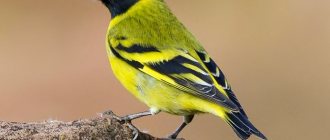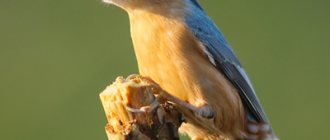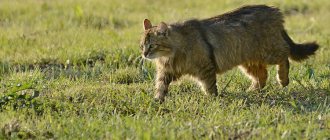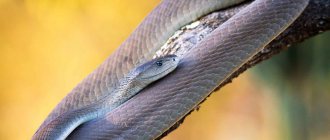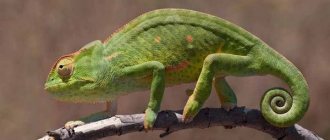Spread the love
Well, who, if not the starling, can imitate all kinds of sounds like that? Some eyewitnesses claimed that they even heard the meowing of cats from the flocks of birds flying past. And this is only a small part of the starling’s parody gift.
It is worth getting to know the starling bird in more detail, finding out what starlings eat, and whether these birds are migratory or not.
What does a starling look like?
These birds are often compared to the blackbird. The similarity here can be seen in size, dark plumage and beak color . However, a starling can be easily distinguished from a thrush by its short tail, its body with small and light speckles, and its ability to run on the ground. In the spring, light specks are more visible in females, but by the onset of autumn these spots are erased due to molting.
The beak of common starlings is of medium length and very sharp, slightly curved downwards. During the mating season, the beak acquires a yellow tint, the rest of the time it becomes black. Until starling chicks reach puberty, their beaks are brownish-black. Chicks that have not reached puberty are also distinguished by a brown tint of plumage, rounded wings and a light throat.
The size of a common starling is usually 22 cm and weight – 75 g . The wingspan of the common starling is 39 cm. The body of the individuals is massive, resting on red-brown paws. The head is proportionate, round in shape. The tail of common starlings is very short, its length is 6-7 cm.
There are several geographical subspecies of starlings, which differ in the shades of their metallic feathers. For example, the feathers of European starlings have a green and purple tint; in other subspecies, the back, chest and back of the neck have a blue and bronze tint.
Description, appearance
The starling is constantly compared to the blackbird, citing the similarity of their size, dark shiny plumage and beak color.
The fact that this is, after all, a starling is indicated by its short tail, its body covered in small light specks, and its ability to run on the ground, unlike bouncing blackbirds. In spring, the light specks are more visible in females, but by autumn, thanks to molting, this feature is erased.
The beak is moderately long and sharp, slightly curved downwards: yellow - in the mating season, in other months - black . Until the chicks reach puberty, their beaks are colored only brownish-black. Young starlings are also distinguished by the general brown tint of their feathers (without the bright gloss inherent in adults), the special roundness of their wings and a light neck.
This is interesting! It has been established that the color of the metallic tone is determined not by the pigment, but by the design of the feathers themselves. When the angle and lighting change, the flickering plumage also changes its shades.
The common starling does not grow more than 22 cm with a weight of 75 g and a wingspan of almost 39 cm. It has a massive body resting on reddish-brown legs, a proportionate round head and a short (6-7 cm) tail.
Ornithologists divide starlings into several geographical subspecies, whose black feathers are distinguished by shades of metallic luster. Thus, European starlings shimmer green and purple in the sun, while in other subspecies the back, chest and back of the neck shimmer blue and bronze.
Male and female: main differences
Sexual dimorphism in all starling species is rather weakly expressed. So, for example, the male and female common starling differ in the feathers on their chest - in females they are more graceful and shorter. In addition, females have red dots at the base of the beak, while males have a blue spot.
In other species, females and young are slightly lighter than male starlings.
Range, habitats
The common starling lives in all geographical areas except Central and South America. Starlings began to be imported to Africa, Australia and North America back in the 19th century, where the species successfully adapted to living conditions.
Starlings living in the south and west of Europe lead a sedentary lifestyle; the northern and eastern populations migrate to the south of Europe, India and African countries before the onset of cold weather. The distance between wintering and nesting can reach 1-2 thousand km.
This is interesting! In the east, the range extends to Lake Baikal (inclusive), and in the west it covers the Azores. The starling has been seen in Siberia at approximately 60° north latitude.
Migrating starlings return to nesting grounds in February-March, northern populations - in early May, with females arriving several days later than males.
At wintering grounds, starlings gather in huge flocks of more than a million individuals. During nesting they live in small groups of several pairs. They prefer to settle in flat landscapes, open forests, swamps and along the banks of reservoirs. Often found in rural areas, where there is more food and it is easier to find a nest site.
Departure for the winter
Starlings winter in Central or Southern Europe, as well as in Asia, India and North Africa. Obeying instinct, they yearly return to the place where they were born and first saw sunlight. In this they are very similar to swallows .
Sometimes starlings have to fly over 3 thousand miles, including over the Mediterranean and Black seas. They can cover up to 80 miles per hour, making only 2-3 stops a day.
According to eyewitnesses' descriptions, when meeting sea vessels, these birds seek protection from people and descend in clouds onto the decks. After all, during hurricanes the entire flock can die.
According to old legends, ships on which at least one bird was killed seeking shelter are in danger of imminent death.
Interesting! The departure time of starlings coincides with the beginning of September, although in warmer regions this time may shift to mid-October.
These birds return to their homeland quite early. The first time after arrival, starlings, like swifts , stay in flocks. Their arrival is a special sight.
One flock can contain several thousand birds. Flying high in the sky, they make synchronized movements. You can see what these celestial acrobats look like in the photo below.
flock of starlings
According to the description of ornithologists, in all species of starlings, the scout males are the first to return. The females arrive a little later, about a week later, at a time when their partners have already chosen nesting sites.
If the male looking after the nest fails to find a mate in time, he is left alone.
Interesting! After the chicks of the second clutch leave the nests, the starlings gather in flocks again. They can spend the night on several nearby trees. Moreover, starlings perfectly sense any weather changes. If they gather in small flocks and begin to “lead” round dances, it’s bad weather.
Starling lifestyle
The most difficult life is for migratory starlings returning home in early April . It happens that at this time snow falls again, driving away the birds to the south: those who did not have time to migrate simply die.
The males arrive first. Their friends appear a little later, when the potential chosen ones have already chosen places for nesting (including hollows and birdhouses), and are now honing their vocal abilities, not forgetting to fight with their neighbors.
The starling reaches up, opening its beak wide and fluttering its wings. Harmonious sounds do not always come out of his throat: he often squeals and squeals unpleasantly. Sometimes migratory starlings skillfully imitate the voices of subtropical birds, but more often Russian birds become role models, such as:
- oriole;
- lark;
- jay and thrush;
- warbler;
- quail;
- bluethroat;
- martin;
- rooster, chicken;
- duck and others.
Starlings can imitate not only birds: they flawlessly reproduce a dog's bark, a cat's meow, the bleating of a sheep, a frog's croak, the creaking of a gate/cart, the crack of a shepherd's whip, and even the sound of a typewriter.
The singer repeats his favorite sounds in a patter, ending the performance with a shrill squeal and “clinking glasses” (2-3 times), after which he finally falls silent. The older the starling, the more extensive its repertoire.
Bird behavior
The common starling is not a particularly friendly neighbor: it quickly gets involved in a fight with other birds if a profitable nesting site is at stake. Thus, in the USA, starlings displaced red-headed woodpeckers, native to North America, from their homes. In Europe, starlings compete for the best nesting sites with green woodpeckers and rollers .
Starlings are sociable creatures, which is why they gather in flocks and live in closely spaced colonies (several pairs). In flight, they create a large group of several thousand birds, synchronously soaring, turning and landing. And already on the ground they “scatter” over a huge area.
This is interesting! While incubating and protecting their offspring, they do not leave their territory (with a radius of approximately 10 m), keeping other birds away. They fly to vegetable gardens, fields, cottages and the banks of natural reservoirs to forage.
They also usually spend the night in groups, usually on the branches of trees/shrubs in city parks and gardens or in coastal areas densely overgrown with willows/reeds. At wintering grounds, a company of overnight starlings can consist of more than a million individuals.
Migration
The further north and east (in European regions) starlings live, the more seasonal migrations are typical for them. Thus, the inhabitants of England and Ireland tend to become almost completely sedentary, and in Belgium almost half of the starlings fly south. A fifth of Holland's starlings spend the winter in their homeland, the rest move 500 km south - to Belgium, England and Northern France.
The first batches migrate south in early September, as soon as the autumn molt ends. The migration peaks in October and ends by November. Lonely young starlings are the fastest to gather for the winter, starting in early July.
In the Czech Republic, East Germany and Slovakia, wintering birds account for approximately 8%, and even fewer (2.5%) in Southern Germany and Switzerland.
Almost all starlings inhabiting eastern Poland, northern Scandinavia, northern Ukraine and Russia are migratory. They spend the winter in southern Europe, India or northwest Africa (Algeria, Egypt or Tunisia), covering a distance of 1-2 thousand kilometers during flights.
This is interesting! Traveling starlings, arriving south in the thousands, are extremely annoying to the local population. Almost all winter, the residents of Rome do not really like to leave the house in the evenings, when the birds that fill the parks and squares chirp so much that they drown out the noise of passing cars.
Some starlings return from the resort very early, in February-March, when there is still snow on the ground. A month later (at the beginning of May) those who live in the northern regions of the natural range fly home.
Lifespan
The average lifespan of common starlings has been documented . Information provided by ornithologists Anatoly Shapoval and Vladimir Paevsky, who studied birds in the Kaliningrad region at one of the biological stations. According to scientists, in the wild, common starlings live for about 12 years.
Features of character and lifestyle
Starlings live in large flocks and can vary in abundance at different times of the year. Sometimes these are very large flocks; during flight they look like a dense sphere, which, as they move, either contracts or expands. This happens without the participation of a clear leader; each member of the flock can change the trajectory of movement, influencing their neighbors. Such aggregations provide protection from birds of prey such as sparrowhawks or peregrine falcons.
In some cities and forest parks, such large concentrations of birds form huge flocks of up to one and a half million individuals, which is a real disaster, since droppings from such flocks can accumulate and amount to up to 30 cm. This concentration is toxic and causes the death of plants and trees. Large flocks can be observed in March on the island of Jutland and on the marshy coasts of southern Denmark. During the flight, they look like a swarm of bees; the local population calls such clusters the black sun.
Such phenomena are observed before birds from Scandinavia begin migrating to their summer habitats in mid-April. Similar flocks, but numbering 5-50 thousand individuals, form in winter in Great Britain at the end of the day. The starling can make various sounds and songs; this bird is an excellent imitator. Starlings repeat the sound even after one listen. The older the bird, the more extensive its repertoire. Males are more skilled at singing and do it more often.
Interesting fact: Female starlings choose partners with a larger set of songs, that is, more experienced ones.
Vocalization consists of four types of melodies that transition into one another without pauses. They can imitate the singing of other birds, the sounds of cars, metal knocks, and creaks. Each sound series is repeated several times, then a new set is sounded. There are repeated clicks between them. Some birds have a repertoire of three dozen songs and one and a half dozen different clicks. The main surge in vocalization is observed during the mating season, when the male tries to attract a partner with his singing, as well as scare away other contenders from his territory, although their singing and screams can be heard at any time of the year.
Nutrition, starling diet
The good life expectancy of this small bird is partly explained by its omnivorous nature: the starling eats both plant-based and protein-rich foods.
The latter includes:
- earthworms;
- snails;
- insect larvae;
- grasshoppers;
- caterpillars and butterflies;
- symphylos;
- spiders.
Flocks of starlings ravage vast grain fields and vineyards, causing damage to summer residents by eating garden berries, as well as fruits/seeds of fruit trees (apple trees, pears, cherries, plums, apricots and others).
This is interesting! The contents of the fruit, hidden under a strong shell, are obtained by starlings using a simple lever. The bird inserts its beak into a barely noticeable hole and begins to expand it, unclenching it over and over again.
What do they eat?
Starlings eat a variety of plant and animal products at any time of the year. Young birds eat mainly animal products, such as soft invertebrates. Adults prefer plant foods and obtain them by searching on the ground in open areas with short or sparse vegetation. Starlings sometimes follow farm equipment as it lifts soil. They also feed in intertidal areas, sewage treatment plants, garbage dumps, farms, and livestock feeding areas. They flock to trees where there are ripe fruits or many caterpillars.
Starling food consists of:
- seeds;
- insects;
- small vertebrates;
- invertebrates;
- plants;
- fruit.
Starlings feast on:
- centipedes;
- spiders;
- moths;
- earthworms.
From plant foods they prefer:
- berries;
- seeds;
- apples;
- pears;
- plums;
- cherry
The shape of the skull and muscles allows starlings to penetrate the ground with their beaks or break into solid food and open holes. Birds have binocular vision, see what they are doing and distinguish between types of food.
Bird breeding
Resident starlings begin mating in early spring, migrating starlings begin mating after arrival. The duration of the mating season depends on the weather and the availability of food.
Pairs nest not only in birdhouses and hollows, but also in the foundations of the homes of larger birds (herons or white-tailed eagles). Having chosen a place, the starling calls the female by singing, at the same time notifying competitors that the “apartment” is occupied.
Both build the nest, looking for stems and roots, twigs and leaves, feathers and wool for its bedding . Starlings have been observed to engage in polygyny: they not only charm several females at the same time, but also fertilize them (one after another). Polygyny also explains three clutches per season: the third occurs 40-50 days after the first.
In a clutch, as a rule, there are from 4 to 7 light blue eggs (each 6.6 g). The incubation period lasts 11-13 days. During this time, the male occasionally replaces the female, who is constantly sitting on the eggs.
The fact that the chicks have been born is signaled by the shell under the nest. Parents rest in fits and starts, mostly at night, and in the morning and evening they are busy searching for food, going out to buy baby food several dozen times a day.
At first, only soft food is used, later replaced by grasshoppers, caterpillars, beetles and snails. After three weeks, the chicks can already fly away from the nest, but sometimes they are afraid to do so. Luring out the “alarmists,” adult starlings circle around the nest with food clutched in their beaks.
THIS IS INTERESTING!
Now let's look at some interesting facts about starlings. An adult is an excellent imitator: it can reproduce the voices of its fellow birds: bullfinch, woodpecker, tit. It is interesting to note that the starling reproduces the croaking of frogs. Some individuals imitate cats in meowing. If a large flock lands on a tree, the branches will immediately break.
In some countries, birds are highly valued because they can repel insects! In New Zealand people love to build birdhouses. There are not as many starlings in the territories of our country as there were before.
This is due to the fact that livestock breeders have reduced the number of pastures where agile birds found food. Now we know what starlings look like and what lifestyle these birds prefer!
2.Starlings are songbirds. Their original homeland is Europe, but they are now found all over the world. They are widespread on many continents.
3. This chirping bird can be found in almost all parts of the world, because it easily adapts to various natural conditions.
4. Starlings rarely visit Central and South America. They live well in Russia, France, Yugoslavia, Greece, Pakistan, India, Afghanistan, and Iraq. People have already settled these birds in Africa and Australia.
5.The most favorite places for starlings to settle are Australia, Eurasia, New Zealand, and North America.
6. The size of the starling is considered average for passerines. The weight of an adult bird is about 75 grams, body length is 20-22 centimeters, wingspan is 40 centimeters. They have a relatively massive body, short neck and shortened tail.
7. Starlings have black plumage with a metallic tint, which in the spring can be moulted and turn brown. Some of these birds have purple, bronze, greenish, and bluish tints on their feathers.
8. Males are slightly larger than females and brighter
9. Starlings have a sharp and long beak, slightly curved downwards. The beak also has the property of changing color. Most of the time it is black for the starling, but during the mating season it turns yellow.
10.The feet of these birds are large and strong, brown-red in color with curved claws.
Common Starling
11. The plumage of an adult common starling is black, with a characteristic metallic sheen. There may be white spots above the wings and on the head, the throat and head area is purple, the abdomen is blue, and the back is greenish.
12. In addition to the common starling, 12 more species of starlings are found in nature, including: pink starling, Brahmin starling, black starling.
13. Are starlings migratory birds or not? The answer to this question is twofold. Starlings in the western and southern parts of Europe lead a sedentary life, that is, they stay here for the winter.
14. And in Russia, in the east and north of Europe it is cold for them to winter, so they fly to southern countries.
15. Starlings arrive to us at the end of March - beginning of April and are often greeted by a prolonged winter in their homeland. But bad weather doesn’t really bother these cheerful birds. They can be seen singing cheerfully under the continuously falling flakes of wet snow.
Pastor
16. The favorite habitat of these birds is flat terrain. They do not fly into mountainous areas. They choose areas near rivers or swamps as their preferred places to settle. Sometimes they can be found in steppe areas and open forests.
17. Starlings’ homes are often found near farms and human houses. They like to settle near fields where they get their food.
18.Most birds live in hollows or under niches of buildings. They are also not averse to living in cozy birdhouses built by people.
19. In spring, males are the first to arrive, occupying tree hollows, voids behind the siding of a house or window, and birdhouses, evicting sparrows from them. Having flown from southern countries, starlings enter the mating season. In European and Asian countries, they manage to hatch chicks three times from spring to autumn.
20.To do this, the birds are divided into pairs. Then they look for nesting places and bring dry parts of plants there. Moss, feathers, and grass are placed on top of the bird. A male can court several females at once.
21. The first clutch of eggs can contain from 6 to 10 eggs. The eggs are blue in color and reach 3 centimeters in length and 2 centimeters in width. The weight of one is 6.5 grams. The female lays eggs once a day.
22.Then she hatches them. Sometimes the female is replaced by a male while incubating the offspring.
23. Chicks are born on days 11-13. They are completely naked and blind. At first they behave completely silently. As soon as the parents threw the egg shells out of the nest, the chicks appeared. Adults begin to look for food for their offspring. They bring insects to the chicks, which is a complete protein food. Parents can fly for food up to 300 times per day. After three weeks of life, the chicks make their first flight. Parents use various tricks to lure them out of the nest.
24. The most ardent enemies of starlings are crows and magpies. These birds are capable of destroying their nests. Starlings are also afraid of eagles, golden eagles, peregrine falcons, owls, and falcons. These predators make their way to nests in search of eggs and chicks, which they eat.
25. Cats, martens, snakes can also get to the nest and eat small chicks.
Black starling
26. Their numbers are declining due to habitat loss, but globally the starling population remains stable and they are not listed as endangered.
27. Starlings live in colonies, forming flocks. You can often see thousands of birds flying by, resembling a swarm of bees in the distance. The birds perform complex pirouettes one after another, and the whole flock seems to be one whole organism. Before landing, they hover above the ground, and then scatter over a wide area.
28.They also gather in groups to spend the night. For this, places where willows and reeds grow are suitable for them. In a city park or garden, they simply sleep on the branches of trees and bushes. In those countries where they winter, flocks can number up to a million individuals.
29. During the period of hatching chicks, starlings live in their own small territory and do not allow other birds there. They find food on river banks, crops, vegetable gardens, and in villages. They do not carry food into the nest; they eat it to the side. Starlings are aggressive towards other birds; they compete for nesting sites. Birds such as rollers and green woodpeckers fall prey to their behavior.
30. In a family of starlings, the female is responsible for building the nest; her partner only helps to obtain building material.
31. The starling’s own song can hardly be called a song in the full sense of the word: it is rather some kind of chirping, muttering with whining and crackling sounds, in general, not very melodic. But it is sung with sincere passion, for which the singer is forgiven for his very mediocre art.
32. The most remarkable thing is that among this intimate talking and whistling, the singing of many different birds, the voices of animals and other sounds that he had ever heard are heard from time to time, and quite clearly. It is not difficult for starlings to imitate a telephone ringing, the creaking of a door, the croaking of a frog, the meowing of a cat, or some kind of melody.
33. The starling bird has an amazing talent for imitation. Once upon a time, scientists recorded a song from one of these masters of voice imitation. This starling perfectly conveyed the voices of a kite, terns, magpies, orioles, sparrows, jackdaws, cranes, mallards, sang with a warbler, a redstart, croaked like a frog, and even made some sounds unknown among our animals and birds.
34. Sometimes starlings even learn to speak, and very clearly pronounce not only individual words, but also entire phrases, second only to parrots in this regard.
35. If you observe starlings, you can note some of their features: in flight, the starling makes fast and even movements, but in the process of catching insects, it makes irregular movements.
Brahmin starlings
36. People used to admire these early songbirds. They put starlings in a cage like a canary or a nightingale.
37. Starlings arrive in Russia in March, with the first thaw. They prefer to live in sparse forests, steppes, and forest-steppes.
38. These birds are omnivores. They eat berries, seeds, grains, fruits, spiders, snails, worms, and centipedes. Plant food is preferred in the summer, and insects are consumed in the winter, getting them from cracks in the bark of trees.
39. Adult starlings have black plumage with light specks, and young ones have pale brown plumage, so the chicks are easily recognized in the general flock.
40. Returning from warm regions, starlings can form flocks of several thousand individuals, but in forests they live in small flocks.
41. Male starlings sing for most of the year, interrupting only for a few weeks during molting. They have the habit of singing in winter early in the morning before flying out to search for food and in the evening when they arrive at their resting places.
42. The place of mass gathering of these birds quickly becomes soiled with droppings, because a flock can consist of tens of thousands of individuals. Because of this, vacation spots often change.
43. A huge flock does not take off all at once, but in stages, that is, the birds adhere to a certain take-off system. Therefore, thousands of birds rise into the air within 3 minutes and quickly disperse throughout the surrounding area.
44. These small birds are long-lived. In the wild, they usually live 10-12 years, but the maximum lifespan is 15 years or more. This is a respectable age, and many pichugas reach it.
45. One of the reasons for the popularity of starlings among people is their good adaptation to civilization. They live next to a person without experiencing any discomfort. People have long had a tradition of making birdhouses for starlings during the breeding season. This is practiced in Russia, Scandinavia, and Great Britain. Their appearance in these countries symbolizes the arrival of spring.
46. Starlings can also be kept in captivity: for this you need a spacious cage or aviary equipped with perches, a house, feeders, drinkers and toys. There are no special problems with feeding; they can be given soft food for birds, crickets, worms, chopped eggs, cereals, cottage cheese, white bread, pieces of fish or meat, and more.
47.The close proximity of humans and their direct protection saves starlings from many enemies, thanks to which they multiply very quickly. The chicks that fly out of the nest at first stay with their parents, then they gather in flocks and begin to wander through the meadows and pastures.
48. Starlings can be called saviors from pests. Nesting in parks, gardens, groves, on the edges of forests, starling birds feed in open places - in fields, meadows, vegetable gardens, where they collect mollusks, worms, insects, including such harmful ones as orthoptera, chafers and their larvae , wireworms, flies, horseflies, gadflies.
49. One pair of starlings destroys about 8 thousand cockchafers, and the total mass of insects destroyed while feeding the chicks is 6 kg per family. Finally, they can constantly be seen on the backs of sheep and cows, where they collect ticks and lice.
50. All this makes starlings man’s best friends, despite the fact that on occasion they do not refuse to eat grapes or cherries. This harm in our area is completely insignificant, but starlings deserve protection, both in rural areas and in cities.
photo from the Internet
Starling and man
The common starling has a very ambiguous relationship with humanity . This harbinger of spring and gifted singer managed to spoil the good attitude towards himself with several details:
- introduced species displace native birds;
- large flocks of birds at airports threaten flight safety;
- cause significant damage to farmland (grain crops, vineyards and berry fields);
- are carriers of diseases dangerous to humans (cysticercosis, blastomycosis and histoplasmosis).
Along with this, starlings actively destroy agricultural pests, including locusts, caterpillars and slugs, chafers, as well as dipterous insects (botflies, flies and horse flies) and their larvae. It’s not for nothing that people have learned to make birdhouses, attracting starlings to their gardens and dachas.
What role do starlings play in the ecosystem?
The abundance of starlings makes them important prey for small predators. Starlings reproduce quickly, establish new habitats, produce numerous offspring each year, and eat a variety of foods and habitats. They have a significant impact on seed and fruit crops and insect populations. In areas where starlings are not a native species, they displace other birds if they compete with them for nesting sites and food resources.
Types of starlings
Amethyst starling
The amethyst starling lives in Africa north of the Sahara Desert. Its lifestyle is no different from that of an ordinary starling. From October, he begins to build a nest and have chicks. In March, the chicks already begin to fly.
2-4 pale blue eggs are found in the nest. The female incubates the eggs for 2 weeks. Then the starlings feed their chicks for about a month. Amethyst starlings feed on insects and the fruits of berry trees.
Common buffalo starling
The buffalo starling is a small bird. It differs from ordinary starlings in its unusual, thick, brightly colored beak and very strong legs.
Buffalo starling photo on an ungulate - often feeds on insects that parasitize the skin of ungulates.
Swallow Starling
Of the genus Artamus, a member of the starling family, which, however, is distributed as far west as India, most of the approximately 20 species are found in the Australian animal distribution area. Species of this genus combine the properties of starlings, shrikes and swallows, and are especially distinguished by long wings similar to the wings of swallows; They lead a lifestyle similar to that of swallows.
These birds, staying along river banks and in savannas, catch insects in flight, like swallows. Their flight consists of an alternation of wing beats with soaring, but is inferior to the flight of swallows in speed; They either rise high into the air or fly just above the surface of the water. On the ground, short-legged swallow starlings are very awkward. They make their nest in trees, their eggs look like the eggs of shrikes.
The tree swallow starling, equal in size to our swift, is gray above, reddish-brown below, with a white stripe above the eye. Australian short-legged starlings are the bare-eyed starlings (Sphecotheres), distinguished by their bare eye circumference and frenulum; four of their species are distributed throughout Australia and New Guinea.
We have not listed all types of starlings. There are also bronze starling, tree white-headed starling, golden starling, brass, copper, plain, rice, steel (gray), mourning (black) starling, tailed starling.
Red-winged Starling
The Red-winged Starling has small red accents on its wings. This is a rather large bird, about 27-30 cm long. With an elongated neck. This species of starling was discovered by Linnaeus in 1766.
You can get a complete picture of this starling by looking at the photo.
Waller's Starling
This bird was discovered by English naturalist Gerald Waller in 1880. In the key it is listed as Onychognathus walleri.
It lives in Burundi, Cameroon, Congo, Guinea, Kenya, Uganda, Tanzania, Nigeria, Rwanda and Zambia.
Black-winged Starling
The black-winged starling (Acridotheres melanopterus) is a species of starling in the family Sturnidae. This species is also known as the black-winged mynah or white-breasted starling. Its main habitat is in Indonesia. There are three recognized subspecies of this starling: the nominate species, which is found across most of the island of Java; the tricolored starling, which is restricted to southeast Java; and the third species, which is located in Bali.
The black-winged starling is a small bird - about 23 cm in length. The plumage of this species is striking; its head, chest, back and rump are white, while the tail and parts of the wings are glossy black. The tip of the tail and wings are also white. The skin around the eyes is yellow. The beak is yellow and slightly darker towards the base. The tricolor subspecies is similar to the main one, but has a gray back and very deep black on the wings. And the third subspecies is similar to the tricolor one, with the difference that its black back becomes gray closer to the tail.
The black-winged starling feeds on a variety of fruits, nectar and insects. It feeds in small groups and in pairs, both in trees and on the ground.
In 2010, this species was listed in the Red Book.
Pastor
The starling family is represented in the Caspian region by the pink starling (Sturnus roseus). The predominant color of an adult bird is pink, the head, wings and tail are black, there is a crest on the head; young birds do not have a crest, are brown-gray in color with a whitish throat and indistinct spots on the chest. The length of the pink starling is approximately 21 cm. From the Caspian region it is distributed east to Mongolia, and west to the Danube lowland, where it visits Bulgaria annually, and in some years it is even very common here. In its behavior, the pink starling is very similar to our European starling.
Like the latter, he runs through the meadows and nods, searching them; it also forms flocks in which individual individuals stay, however, not as closely around each other as our starlings. Pink starlings also differ from these latter in that they fly much more and generally behave more restlessly. Yes, they have to fly around vast areas every day to find food for themselves, and also to catch insects in flight, like bee-eaters.
However, the pink starling usually collects insects on the ground. Here he looks for them, like our starling, and like him, he accompanies herds of cattle, sheep and pigs in order to catch the gadflies and horse flies scurrying around these animals.
He also sits on animals, freeing them from ticks and lice, which is why the animals willingly tolerate him. The main food of the pink starling, however, is migratory locusts, which are found in its homeland in whole swarms resembling clouds. According to the Turks, the bird kills 99 out of a hundred of these insects, and eats only the hundredth.
For the extermination of locusts, the peoples of his homeland consider the pink starling almost a sacred bird; here he is guarded everywhere, protected and never killed. On the other hand, the owners of rice fields in India call the rose-colored starling, which, in addition to insects, also feeds on berries, fruits and grains, is a devil's bird and is so afraid of it that they post guards in order to prevent the harm caused by the bird, which appears here in huge flocks. While the roseate starling winters normally in India, it visits Africa only occasionally.
At irregular intervals, the rosy starling visits Italy, France and even England, as well as other countries located between the newly renamed ones and its breeding area. During these flights, pink starlings usually join our starlings and visit the same pastures as them, specifically pastures for livestock. The pink starling is also a social bird, living in larger or smaller flocks, but going to roost quietly and calmly, without the noise so characteristic of our starlings.
In general, the pink starling prefers to choose tall trees for roosting at night, but since there are almost none in its homeland, it has to be content with the thickets of willow trees bordering the banks and river beds. There is always a pink starling’s nest near the water, which is an artless construction made of dry twigs and straws. Sometimes it nests in such huge colonies that, due to lack of space, some pairs have to nest on the ground between grass and stems.
In general, the pink starling builds a nest in hollows of trees, in cracks and holes of steep cliffs and rocks, in ruins and stone walls, in firewood warehouses and piles of brushwood. Occasionally, this bird nests outside its real homeland, where it spends time from late April to August. The fact is that, like other birds of those countries, the pink starling sometimes undertakes mass migrations.
Video
Social structure and reproduction
Photo: Starling chick
In starlings, males look for a suitable place for a nest, a hollow, and begin to carry dry and green parts of plants there. They often store aromatic herbs, perhaps to attract mates or to repel parasitic insects. They make preparations, stocking up on building materials for the time when their partner appears. Throughout this time, the males sing songs, fluffing up the feathers on their throats, trying to attract the female. Once the pair is created, they continue to build the nest through joint efforts. Nests are created in tree hollows, artificial birdhouses, hollow stumps, niches in buildings, and rock crevices. The nest itself is created from dry grass and twigs. The inside is lined with feathers, wool, and down. Construction takes approximately five days.
These birds are monogamous; polygamous families are less common. Since starlings prefer to live in large colonies, nests can be located close to each other. In polygamous families, males mate with a second partner while the first one incubates the eggs. In the second nest, reproduction is lower than in the first. The breeding season occurs in spring and summer. The female lays eggs for several days. Most often these are five bluish eggs. Their size is 2.6 - 3.4 cm in length, 2 - 2.2 cm in width. The eggs hatch for two weeks, both parents do this, but the female is always on the nest at night. The chicks appear without feathers and are blind; after a week they begin to have down, and on the ninth day they begin to see. During the first week, parents constantly remove droppings from the nest so that humidity does not affect the condition of the chicks, which do not have good thermoregulation.
The chicks are in shelter for 20 days, all this time they are fed by both parents, even after the young leave the house, the parents continue to feed them for about two weeks. In the north of the range, one brood appears per season, in more southern regions - two or even three. In a flock, females left without a mate can lay eggs in other people's nests. Chicks in colonies can move to neighboring nests, driving other babies out of them. About twenty percent of chicks survive to adulthood, when they are capable of breeding. The lifespan of a bird in nature is three years.
Interesting fact: The longest recorded lifespan of a starling was almost 23 years.




